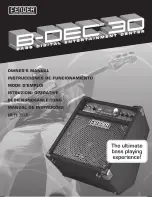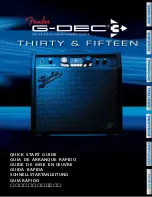
About Equalization
To find out how each graphic equalizer slider affects the sound of your par-
ticular bass, start with all ten bands flat (that is, all ten sliders at their detent-
ed “0” center position). Then, one by one, raise and lower each slider, lis-
tening carefully to the effect of each. If you don’t specifically need to utilize
the ten-band graphic equalizer, bypass it by setting the In/Out switch to its
“Out” position. Alternatively, you can preset a custom graphic equalization
curve (for example, for a feature solo) and activate it simply by pressing the
switch when needed. Note that turning all EQ controls up the same amount
will have virtually the same effect as simply turning up the Master Volume;
conversely, turning them all down the same amount will have virtually
the same effect as turning down the Master Volume. Both approaches are
pointless (after all, that’s why we gave you a Master Volume control!)
In many instances, the best way to deal with equalization is to think in terms
of which frequency areas you need to attenuate, as opposed to which ones
you need to boost. Be aware that boosting a frequency area also has the
effect of boosting the overall signal; specifically, too much low frequency
EQ boost can actually cause overload distortion or even harm a connected
speaker, though the Model 3500/5500’s compression circuitry—if on—will
act to some extent to prevent this from occurring. In general, if you’re going
to apply a fair amount of low frequency EQ boost, it’s a good idea to keep
Compression on, if only to protect your speakers from potential damage.
The specific EQ you will apply to your bass signal is very much dependent
upon your particular instrument and personal taste and playing style.
However, here are a few general suggestions:
•
For that super-deep reggae or Motown sound, boost low frequen-
cies slightly while attenuating the highest ones (leave mid-range
frequencies flat or slightly attenuated), as shown in the illustration
on the right.
•
To remove boxiness and make your instrument sound more “hi-fi,”
try attenuating mid-range frequencies while leaving low and high
frequency settings flat, as shown in the illustration on the right.
•
For a twangy, cutting sound, try boosting the high and high mid-
range frequencies, as shown in the illustration on the right (putting
new roundwound strings on your bass will help a lot also!)
•
Whenever you get a really good EQ setting for a particular instru-
ment or song, write it down (you’d be amazed how easy it is to for-
get these things!).
Finally, as you experiment with the EQ controls of the Model 3500/5500,
don’t forget that your bass also provides EQ controls in the form of its tonal
settings—this can be particularly effective in instruments that have active
circuitry. Also, try various EQ settings with different Pre-Amp blends and
with and without Compression. For more information, see the “About
Compression” section on the following page.
IN
OUT
+15
+12
+9
+6
+3
+2
-2
-3
-6
-9
-12
-15
+15
0
-15
8KHz
5KHz
3KHz
2KHz
1KHz
500Hz
250Hz
125Hz
64Hz
30Hz
IN
OUT
+15
+12
+9
+6
+3
+2
-2
-3
-6
-9
-12
-15
+15
0
-15
8KHz
5KHz
3KHz
2KHz
1KHz
500Hz
250Hz
125Hz
64Hz
30Hz
IN
OUT
+15
+12
+9
+6
+3
+2
-2
-3
-6
-9
-12
-15
+15
0
-15
8KHz
5KHz
3KHz
2KHz
1KHz
500Hz
250Hz
125Hz
64Hz
30Hz
ENGLISH
11
Summary of Contents for HA3500
Page 1: ...350 500 WATT BASS AMPLIFIERS HA3500 HA5500 ...
Page 17: ...Changing the Model 3500 5500 Voltage ENGLISH 13 ...
Page 70: ...66 Notes ...
Page 71: ......
















































